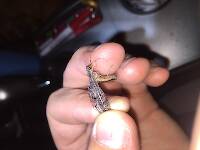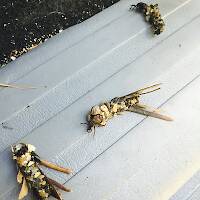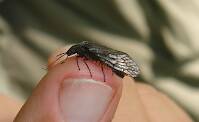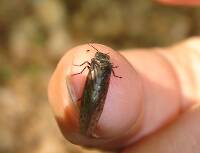
Salmonflies
Pteronarcys californica
The giant Salmonflies of the Western mountains are legendary for their proclivity to elicit consistent dry-fly action and ferocious strikes.
Featured on the forum

Troutnut is a project started in 2003 by salmonid ecologist Jason "Troutnut" Neuswanger to help anglers and
fly tyers unabashedly embrace the entomological side of the sport. Learn more about Troutnut or
support the project for an enhanced experience here.
FredH on Mar 27, 2014March 27th, 2014, 5:49 am EDT
I was given a dobsonfly specimen and I am unfamiliar with them. The photos I have seen before show two large mandibles. This one has no large mandibles and two long feathery antennae.Is the difference due to the insects gender or region, or is it a sub species?
Thanks , Fred
Thanks , Fred
Taxon on Mar 27, 2014March 27th, 2014, 7:10 am EDT
Hi Fred-
I believe you are describing an adult fishfly, which is closely related to a dobsonfly. It's in the same order (Megaloptera) and family (Corydalidae), but in different subfamily (Chauliodinae), rather than (Corydalinae).
Did it look like this?
I believe you are describing an adult fishfly, which is closely related to a dobsonfly. It's in the same order (Megaloptera) and family (Corydalidae), but in different subfamily (Chauliodinae), rather than (Corydalinae).
Did it look like this?
FredH on Mar 27, 2014March 27th, 2014, 7:35 am EDT
Thanks Taxon . That is exactly what it is. I've lived here all my life and this is the first one I have ever seen.
PaulRoberts on Mar 27, 2014March 27th, 2014, 3:07 pm EDT
I'm guessing the feathery antennae means it's a male -if they are anything like moths, finding females via pheromones.
I remember an educator friend telling mew of a meeting he had with a graduate student researching communication in moths. They were to meet by some picnic tables in a park. My friend asked, "How will I recognize you?" She laughed and replied, "Oh, you'll have NO trouble." When he arrived there was a girl sitting at a picnic table with a cluster of moths orbiting her. Her work involved isolating and handling female sex pheromones for a particularly common moth species.
This, presumably, is a female fishfly:

I remember an educator friend telling mew of a meeting he had with a graduate student researching communication in moths. They were to meet by some picnic tables in a park. My friend asked, "How will I recognize you?" She laughed and replied, "Oh, you'll have NO trouble." When he arrived there was a girl sitting at a picnic table with a cluster of moths orbiting her. Her work involved isolating and handling female sex pheromones for a particularly common moth species.
This, presumably, is a female fishfly:

Taxon on Mar 27, 2014March 27th, 2014, 4:04 pm EDT
Paul-
Yes, the operative terms are pectinate (comb-like) and serrate (saw-like).
I'm guessing the feathery antennae means it's a male ...
Yes, the operative terms are pectinate (comb-like) and serrate (saw-like).
Catskilljon on Mar 27, 2014March 27th, 2014, 5:12 pm EDT
Just so I know, do male Fishflies have the large tusks like male Dobsonflies? I see these in the Catskills a lot [they are attracted to my porch lights at night] but a friend told me they were not Dobsonflies.
As far as size is concerned, are Dobsonflies bigger? CJ
As far as size is concerned, are Dobsonflies bigger? CJ
Jmd123 on Mar 27, 2014March 27th, 2014, 8:04 pm EDT
"When he arrived there was a girl sitting at a picnic table with a cluster of moths orbiting her. Her work involved isolating and handling female sex pheromones for a particularly common moth species."
Paul, I have an even funnier story to tell you that a professor who studied insect behavior told us during my entomology Masters at Michigan State. A certain fellow was preparing for some field trapping using sex pheromones to capture gypsy moths (I think or something similar), and they were in a hotel room loading pheromone traps. During the process, one of the researchers needed to use the men's room. Afterward they continued loading taps and prepared for the next day's field work. Well, upon arriving at the field site, moths began to arrive and land on this fellow's crotch all day long, until he had quite a few buzzing around his nether regions..."Why are all these moths on my crotch??" Apparently this fellow had a wedding to attend to a few days later and was standing up as a groomsman, and right in front of the crowd two moths came and landed, you guessed it, right on his crotch...
Moral of the story? Wash your hands!!!
And yes, as a person with an entomology degree, when you see large plumose antennae on an insect, you can assume it's a male. Apparently some of these antennal systems are so sensitive that they can pick up and react to single molecules of pheromones(!), and so can pick up the scents of females at distances of miles.
Jonathon
Paul, I have an even funnier story to tell you that a professor who studied insect behavior told us during my entomology Masters at Michigan State. A certain fellow was preparing for some field trapping using sex pheromones to capture gypsy moths (I think or something similar), and they were in a hotel room loading pheromone traps. During the process, one of the researchers needed to use the men's room. Afterward they continued loading taps and prepared for the next day's field work. Well, upon arriving at the field site, moths began to arrive and land on this fellow's crotch all day long, until he had quite a few buzzing around his nether regions..."Why are all these moths on my crotch??" Apparently this fellow had a wedding to attend to a few days later and was standing up as a groomsman, and right in front of the crowd two moths came and landed, you guessed it, right on his crotch...
Moral of the story? Wash your hands!!!
And yes, as a person with an entomology degree, when you see large plumose antennae on an insect, you can assume it's a male. Apparently some of these antennal systems are so sensitive that they can pick up and react to single molecules of pheromones(!), and so can pick up the scents of females at distances of miles.
Jonathon
No matter how big the one you just caught is, there's always a bigger one out there somewhere...
PaulRoberts on Mar 28, 2014March 28th, 2014, 3:36 am EDT
Just so I know, do male Fishflies have the large tusks like male Dobsonflies? I see these in the Catskills a lot [they are attracted to my porch lights at night] but a friend told me they were not Dobsonflies.
As far as size is concerned, are Dobsonflies bigger? CJ
I don't believe fishflies have the giant mandibles that dobsonflies do. And the dobson's are the larger. Roger?
That's an amusing story, Jonathan. You know, when our parents or teachers said "You never know what you'll end up doing for a living", they weren't kidding. I've done some weird things (from most people's perspective) myself.
Taxon on Mar 28, 2014March 28th, 2014, 5:21 am EDT
Hi Paul-
Adult dobsonfly males have incredibly long crossed, tapered, curved mandibles, whereas the females have short stout mandibles, which more closely resemble those of a Carabid beetle larva.
Adult fishflies probably also possess mandibles, but if so, they are small enough to not be obvious, as in your photo above.
I don't believe fishflies have the giant mandibles that dobsonflies do. And the dobson's are the larger. Roger?
Adult dobsonfly males have incredibly long crossed, tapered, curved mandibles, whereas the females have short stout mandibles, which more closely resemble those of a Carabid beetle larva.
Adult fishflies probably also possess mandibles, but if so, they are small enough to not be obvious, as in your photo above.
Quick Reply
Related Discussions
Topic
Replies
Last Reply
5
Jun 28, 2011
by PaulRoberts
by PaulRoberts
7
Aug 2, 2015
by Entoman
by Entoman
16
May 20, 2008
by Shawnny3
by Shawnny3
8
Jan 24, 2017
by PaulRoberts
by PaulRoberts










